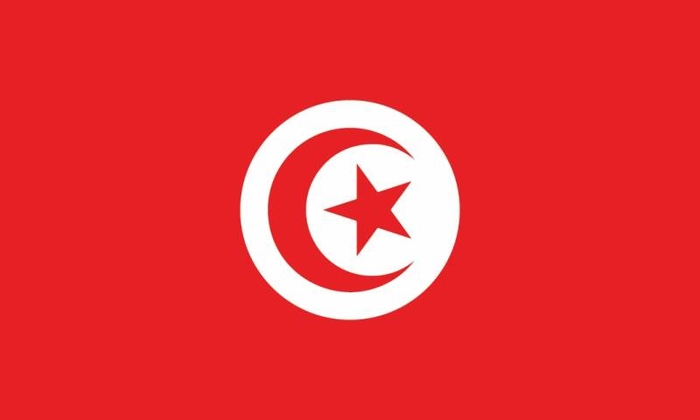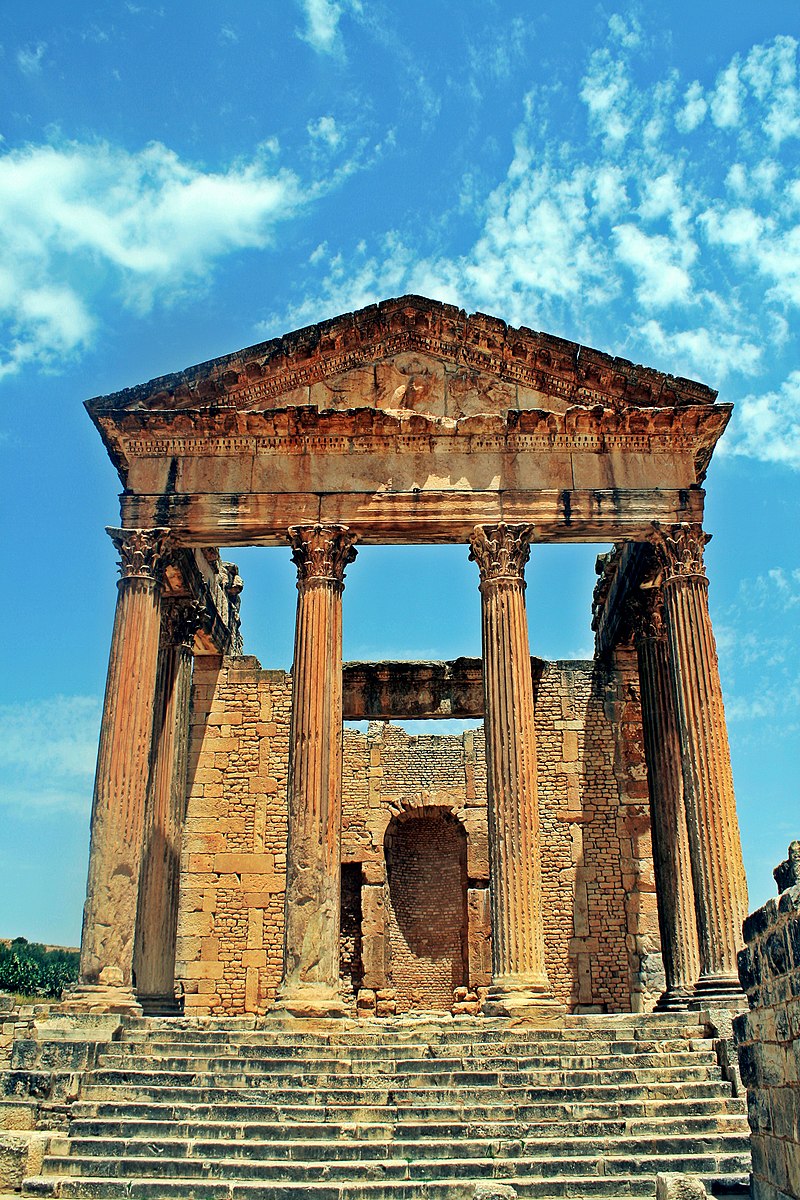227 Tunisia

Red representing the blood shed by martyrs in the struggle against oppression, with a white disk standing for peace in the center bearing a red crescent nearly encircling a red 5-pointed star. The crescent and star are traditional symbols of Islam. Resembles the Ottoman flag (red banner with white crescent and star) and recalls Tunisia’s history as part of the Ottoman Empire.
Flag courtesy of the CIA World Factbook

Map courtesy of the CIA World Factbook

Ruins of Dougga’s World Heritage Site
Government
According to Britannica, for nearly the entire period between Tunisia’s achievement of independence in 1956 and the Jasmine Revolution, a popular uprising that unseated Pres. Zine al-Abidine Ben Ali in 2011, the Tunisian political system featured a powerful presidential regime backed by a single political party. The constitution of 1959 granted the president sweeping executive and legislative powers while placing narrow limits on the authority of the elected legislature and the judiciary. The Neo-Destour Party, led by Tunisia’s first president, Habib Bourguiba, remained the only legal political party until 1981.
Some new political parties were permitted in 1981, permission for a multiparty system was granted in 1988, and the first multiparty elections were held in 1989. However, since the new political parties had neither the financial nor the organizational structure to mobilize serious opposition, Neo-Destour, in 1988 renamed the Democratic Constitutional Rally and known by its French acronym, RCD, retained a monopoly over political activity. Laws forbidding political parties based on ethnicity, religion, region, or language prevented the major opposition group, the Islamist Ennahda (Arabic: al-Nahḍah [“the Renaissance”]) Party, from being granted legal status, and many of its leaders were jailed or exiled. The exclusion of Islamists from politics came to an end in January 2011 with the downfall of the Ben Ali regime, and by late 2011 Ennahda had emerged as the strongest party in the country, winning 90 seats in the 217 member Constituent Assembly tasked with drafting a new constitution to replace the suspended 1959 text.
Tensions between Islamists and secularists at times appeared to threaten Tunisia’s transition to democracy, but they showed a tendency to compromise and cooperate in order to ensure a stable transition. In January 2014, after more than two years of contentious negotiations, the Constituent Assembly voted overwhelmingly to approve a constitution that seemed to be acceptable to all sides. When elections later that year put neither Islamists nor secularists in a commanding position, the largest parties from either side formed a unity government.
The partisanship of the parliament rendered it ineffective in passing important legislation or even appointing members to a constitutional court. Because the court remained vacant, the country was plunged into a constitutional crisis when no judicial body was able to resolve a standoff between the parliament and Pres. Kais Saied that began in January 2021. Saied suspended the constitution in September and put a new constitution to referendum in July 2022. The new constitution, which went into effect following the certification of the referendum, returned Tunisia to a presidential system whose legislative and judicial bodies were significantly limited.
The constitution proclaims Tunisia a republic with Arabic as its language and Islam as its religion. It promises freedom of expression and the right to form political parties and associations, as well as freedom of religious belief.
The unicameral legislature under the 2014 constitution was dissolved in March 2022. Following elections slated for December 2022, the legislature will be bicameral in accordance with the 2022 constitution. The lower house, called the Assembly of the People’s Representatives, originates legislation, provided that bills are introduced by at least 10 members and take budgetary concerns into consideration. Its members will be popularly elected to five-year terms. The upper chamber, called the National Assembly of Regions and Districts, has the power to strip immunity from legislators, but its role in the legislative process is mostly unspecified and will be determined by statute. Its members will be elected by regional and district councils; the length of their terms is not constitutionally specified. Certain constitutional duties must be carried out by both houses, such as the dismissal of government by a two-thirds vote.
The president is directly elected for a five-year term and may be reelected only once, although the tenure may be extended in times of imminent danger. Candidates for president must be Muslim, at least 40 years old, and Tunisian citizens by birth. As head of state, the president is the commander in chief of the armed forces and conducts foreign policy. The president appoints the prime minister and cabinet ministers, who report to the president, as well as members of the judiciary. In addition, the president has the ability to introduce legislation and constitutional amendments and to dissolve parliament.
The country is divided into 24 administrative areas called wilāyāt (provinces; singular wilāyah), each of which is headed by a wālī (governor). Each province is designated by the name of its chief town and is in turn subdivided into numerous units called muʿtamadiyyāt (delegations), whose number varies according to province size. Delegations are administered by a muʿtamad and are in turn divided into more than 2,000 districts called minṭaqah turābiyyahs. Tunisia is further divided into scores of municipalities and rural councils.
Tunisia’s legal system is based on French civil law with some influence from a liberal interpretation of Islamic law (Sharīʿah). The independence and neutrality of the courts are guaranteed by the constitution. The judiciary is made up of the courts of first instance, appellate courts, and the Court of Cassation. A separate system of administrative courts deals with legal disputes between individuals and state or public institutions, and cases concerning the management of public funds are handled by the Court of Audit. The Supreme Judicial Council, a body comprising judges and other legal specialists, oversees the functioning of the justice system.
The Constitutional Court has the authority to rule on the constitutionality of laws and treaties. The constitution assigns nine members to the court: three appointed by the appellate courts, three by the Court of Cassation, and three by the Court of Audit.
Tunisian Civil Aviation and Airport Authority (OACA)
The desired future of the Tunisian Civil Aviation and Airport Authority (OACA) is expressed in their strategic vision 2040 which summarizes their reflections guided by their missions to which they attach values and strategic objectives. This vision is based on the following 5 strategic axes:
- Quality approach to strive for excellence
- Primacy of safety and security
- Preparing for the future
- Marketing approach to better position yourself
- Ambitious policy towards sustainable development.
Airspace
SkyVector – Google Maps – ADS-B Exchange
ICAO countries publish an Aeronautical Information Publication (AIP). This document is divided into three parts: General (GEN), En Route (ENR) and Aerodromes (AD). ENR 1.4 details the types of airspace classes they chose to adopt from classes A through G.
Tunisia AIP – requires login
Drone Regulations
Advanced Air Mobility (AAM) Regulations & Policies
None found by the author.
However, should you, the reader, happen to stumble across something to the contrary, please email the author at FISHE5CA@erau.edu and you may be mentioned in the ACKNOWLEDGEMENTS section of this book by way of thanks for contributing to this free eBook!
Advanced Air Mobility (AAM) News
2025
Video courtesy of Advanced Air Mobility Institute from the July 2025 Global AAM Forum.
2025
Video courtesy of Advanced Air Mobility Institute from the January 2025 Global AAM Forum. Complete session for Day 2 of this Forum is available on the Advanced Air Mobility Institute YouTube Channel
Short Essay Questions
Scenario-Based Question
You have been hired by a Drone Startup Company. Your boss has immediately assigned this job to you.
They need you to prepare a one-page memo detailing the legalities of using a drone to film in Tunisia.
They need you to mention any national laws and local ordinances.
They specifically want to know what airspace (insert pictures) you will be operating in and whether or not you need an airspace authorization.
Does it matter whether or not you are a citizen of the country?
Lastly, there is a bonus for you if, as you scroll through this chapter, you find any typos or broken links!
Short Essay Questions
- What are the drone categories?
- How is registration addressed?
- How is remote ID addressed?
- What are the model aircraft rules?
- What are the commercial drone rules?
- Are there waivers or exemptions to the rules? If so, for what?
- Would you share a link to an interactive airspace map?
- How is BVLOS addressed?
- How can you fly drones at night?
- How can you fly drones over people?
- Where do you find drone NOTAMs?
- What are the rules for drone maintenance?
- What are the rules for an SMS program?
- What are some unique rules not mentioned above?
- What are the C-UAS rules?
- What are the AAM rules?

